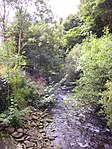Porth County Community School
1973 establishments in WalesEducational institutions established in 1973EngvarB from September 2019Secondary schools in Rhondda Cynon Taf

Porth Community School is a Community School located in the county borough of Rhondda Cynon Taf, Wales. The school was formed in 1973 by the amalgamation of two leading grammar schools, Porth County Girls and Porth County Boys, along with the amalgamation of the Secondary Modern Schools of Llwyncelyn, Trealaw and Ynyshir. Porth is now described as a good school and the previous Porth Infants and Porth Juniors schools have all moved to the Porth Community School to form the new school. Children of various ages attend the school, ranging from 3–16 years old.
Excerpt from the Wikipedia article Porth County Community School (License: CC BY-SA 3.0, Authors, Images).Porth County Community School
A4233,
Geographical coordinates (GPS) Address Nearby Places Show on map
Geographical coordinates (GPS)
| Latitude | Longitude |
|---|---|
| N 51.605 ° | E -3.415 ° |
Address
Ysgol Gyfun Cymer Rhondda
A4233
CF39 9HA , Glynfach
Wales, United Kingdom
Open on Google Maps








